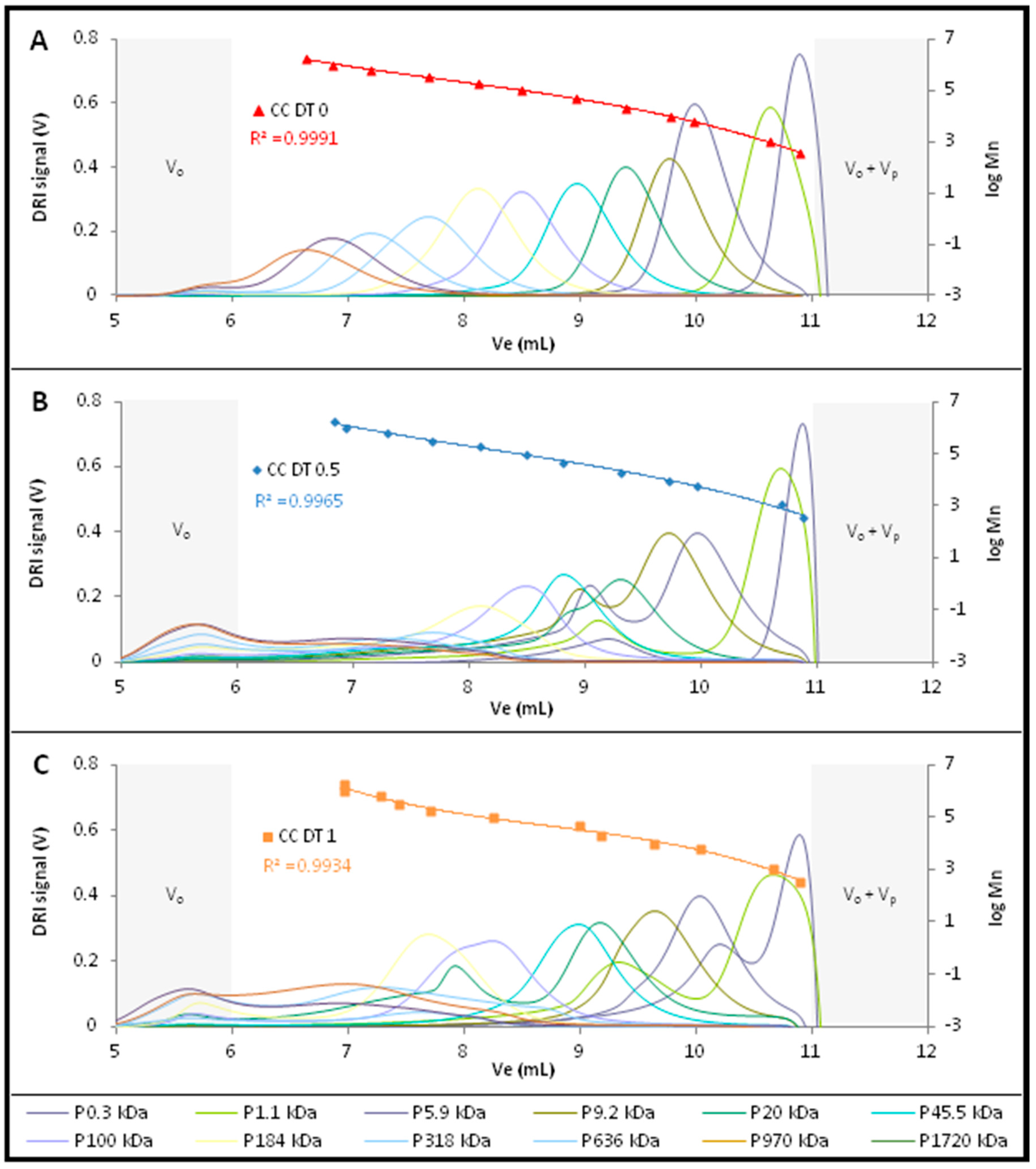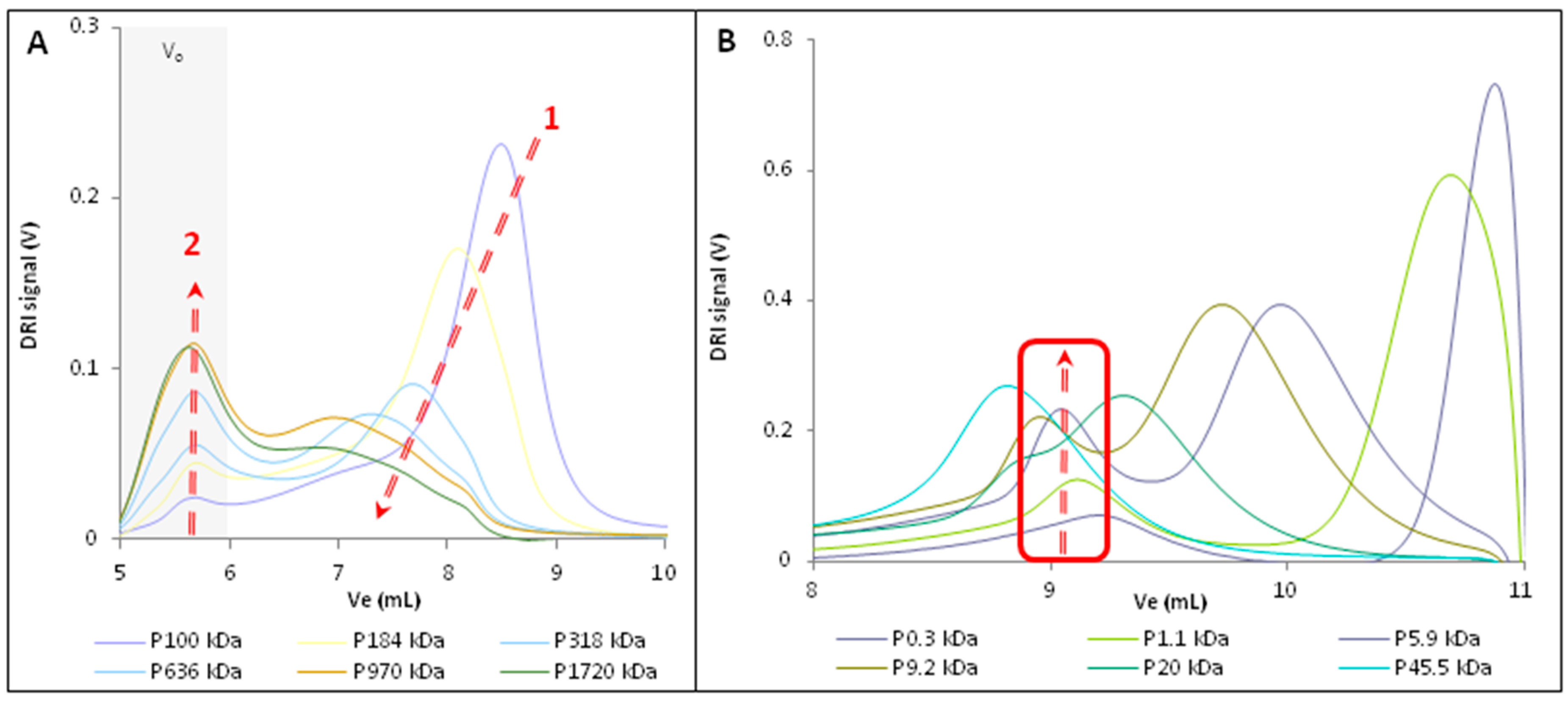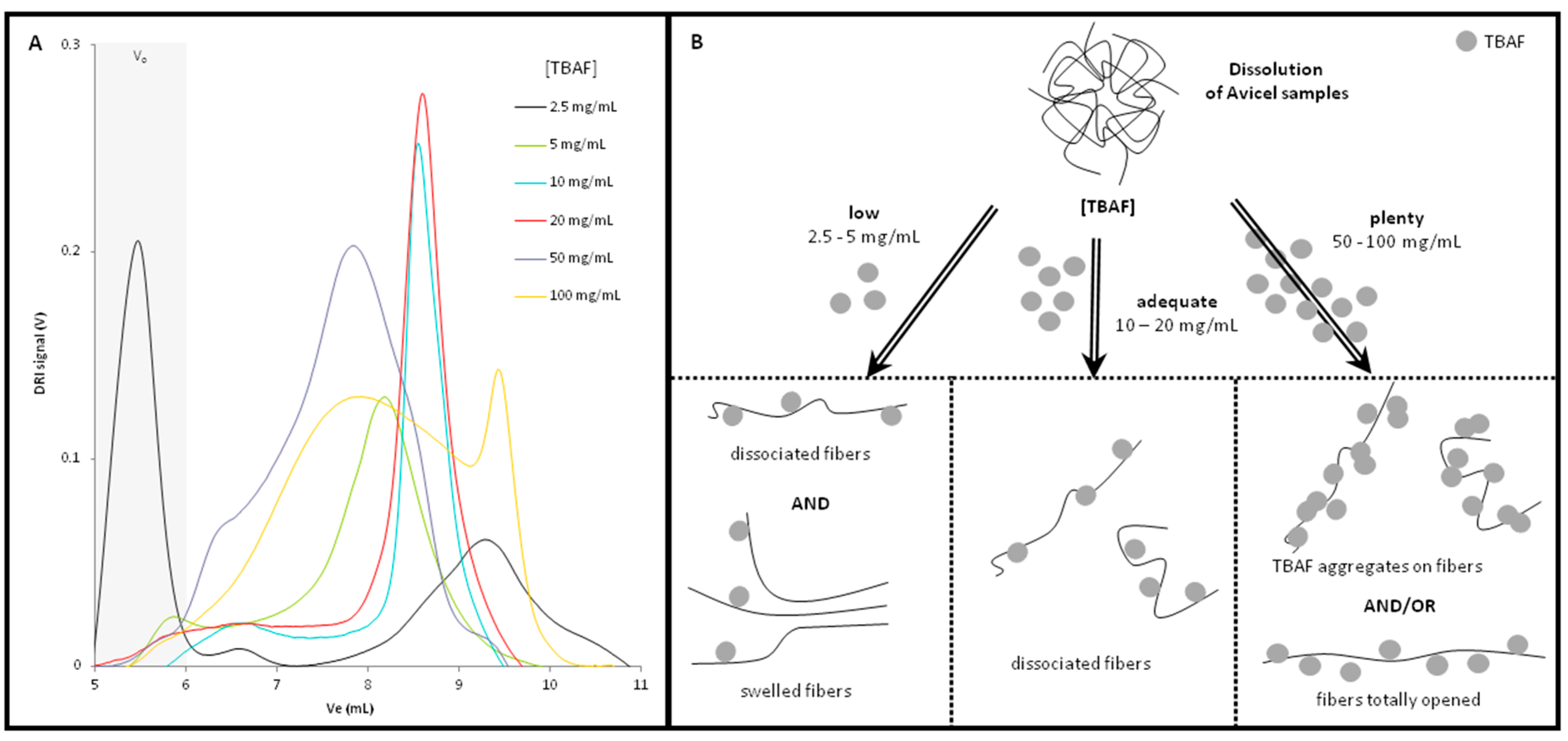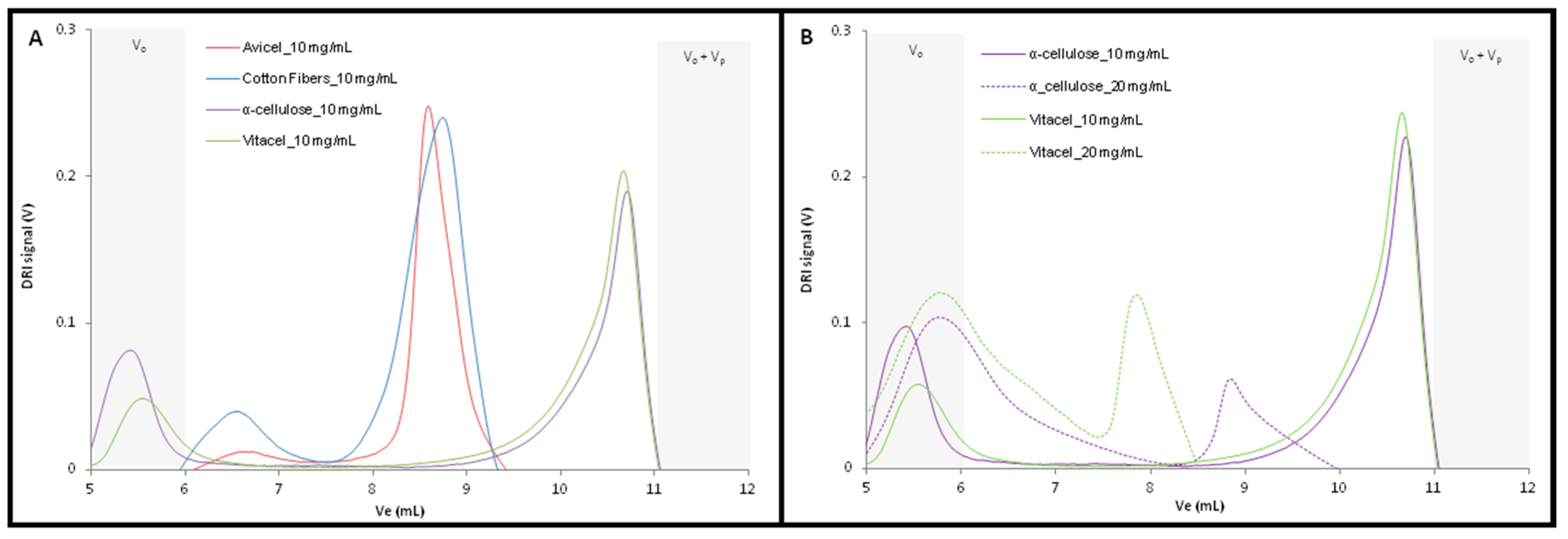Characterization of Non-Derivatized Cellulose Samples by Size Exclusion Chromatography in Tetrabutylammonium Fluoride/Dimethylsulfoxide (TBAF/DMSO)
Abstract
:1. Introduction
2. Results and Discussion
2.1. Influence of TBAF Concentration on Pullulan Calibration Curves
2.2. Effect of TBAF Cencentration on AVICEL® Chromatograms
2.3. Chromatogram and Molar Mass Distribution of Cellulose Samples
3. Materials and Methods
3.1. Materials
3.2. Viscosimetric Measurements
3.3. Standard Procedure for Pullulan Dissolution in TBAF/DMSO
3.4. Standard Procedure for Cellulose Dissolution in TBAF/DMSO
3.5. Size Exclusion Chromatography
4. Conclusions
Author Contributions
Conflicts of Interest
References
- Lauriol, J.-M.; Froment, P.; Pla, F.; Robert, A. Molecular weight distribution of cellulose by on-line size exclusion chromatography—Low angle laser light scattering. Part I—Basic experiments and treatment of data. Holzforschung 1987, 41, 109–113. [Google Scholar] [CrossRef]
- Evans, R.; Wearne, R.H.; Wallis, A.F.A. Molecular weight distribution of cellulose as its tricarbanilate by high performance size exclusion chromatography. J. Appl. Polym. Sci. 1989, 37, 3291–3303. [Google Scholar] [CrossRef]
- Evans, R.; Wearne, R.H.; Wallis, A.F.A. Effect of amines on the carbanilation of cellulose with phenylisocyanate. J. Appl. Polym. Sci. 1991, 42, 813–820. [Google Scholar] [CrossRef]
- Sjöholm, E. Size exclusion chromatography of cellulose and cellulose derivatives. In Handbook of Size Exclusion Chromatography and Related Techniques: Revised and Expanded; Chromatographic Science Series; Wu, C.-S., Ed.; Dekker: New York, NY, USA, 2003; Volume 91. [Google Scholar]
- Henniges, U.; Kloser, E.; Patel, A.; Potthast, A.; Kosma, P.; Fischer, M.; Fischer, K.; Rosenau, T. Studies on DMSO-containing carbanilation mixtures: Chemistry, oxidations and cellulose integrity. Cellulose 2007, 14, 497–511. [Google Scholar] [CrossRef]
- McCormick, C.L.; Callais, P.A.; Hutchinson, B.H. Solution studies of cellulose in lithium chloride and N,N-dimethylacetamide. Macromolecules 1985, 18, 2394–2401. [Google Scholar] [CrossRef]
- Dawsey, T.R.; McCormick, C.L. The lithium chloride/dimethylacetamide solvent for cellulose: A literature review. J. Macromol. Sci. Part C 1990, 30, 405–440. [Google Scholar] [CrossRef]
- Timpa, J.D. Application of universal calibration in gel permeation chromatography for molecular weight determinations of plant cell wall polymers: Cotton fiber. J. Agric. Food Chem. 1991, 39, 270–275. [Google Scholar] [CrossRef]
- Striegel, A.M.; Timpa, J.D. Size Exclusion Chromatography of Polysaccharides in Dimethylacetamide-Lithium Chloride. In Strategies in Size Exclusion Chromatography; ACS Symposium Series; American Chemical Society: Washington, DC, USA, 1996; Volume 635, pp. 366–378. [Google Scholar]
- Strlič, M.; Kolar, J. Size exclusion chromatography of cellulose in LiCl/N,N-dimethylacetamide. J. Biochem. Biophys. Methods 2003, 56, 265–279. [Google Scholar] [CrossRef]
- Sjöholm, E.; Gustafsson, K.; Colmsjo, A. Size exclusion chromatography of lignins using lithium chloride/N,N-dimethylacetamide as mobile phase. I. Dissolved and residual birch kraft lignins. J. Liq. Chromatogr. Relat. Technol. 1999, 22, 1663–1685. [Google Scholar] [CrossRef]
- Dupont, A.-L. Cellulose in lithium chloride/N,N-dimethylacetamide, optimisation of a dissolution method using paper substrates and stability of the solutions. Polymer 2003, 44, 4117–4126. [Google Scholar] [CrossRef]
- Kennedy, J.F.; Rivera, Z.S.; White, C.A.; Lloyd, L.L.; Warner, F.P. Molecular weight characterization of underivatized cellulose by GPC using lithium chloride-dimethylacetamide solvent system. Cellul. Chem. Technol. 1990, 24, 319–325. [Google Scholar]
- Silva, A.A.; Laver, M.L. Molecular weight characterization of wood pulp cellulose: Dissolution and size exclusion chromatographic analysis. Tappi J. 1997, 80, 173–180. [Google Scholar]
- Westermark, U.; Gustafsson, K. Molecular size distribution of wood polymers in birch kraft pulps. Holzforschung 1994, 48, 146–150. [Google Scholar] [CrossRef]
- Turbak, A.F.; El-Kafrawy, A.; Snyder, F.W.; Auerbach, A.B. Solvent System for Cellulose. U.S. Patent 4302252 A, 24 November 1981. [Google Scholar]
- El-Kafrawy, A.; Turbak, A.F. The dissolution of cellulose in anhydrous chloral/aprotic solvents. J. Appl. Polym. Sci. 1982, 27, 2445–2456. [Google Scholar] [CrossRef]
- Turbak, A.F. Newer cellulose solvent systems. Tappi J. 1983, 105–110. [Google Scholar]
- Röder, T.; Morgenstern, B.; Schelosky, N.; Glatter, O. Solutions of cellulose in N,N-dimethylacetamide/lithium chloride studied by light scattering methods. Polymer 2001, 42, 6765–6773. [Google Scholar] [CrossRef]
- Tamai, N.; Tatsumi, D.; Matsumoto, T. Rheological properties and molecular structure of tunicate cellulose in LiCl/1,3-dimethyl-2-imidazolidinone. Biomacromolecules 2004, 5, 422–432. [Google Scholar] [CrossRef] [PubMed]
- Sjöholm, E.; Gustafsson, K.; Pettersson, B.; Colmsjö, A. Characterization of the cellulosic residues from lithium chloride/N,N-dimethylacetamide dissolution of softwood kraft pulp. Carbohydr. Polym. 1997, 32, 57–63. [Google Scholar] [CrossRef]
- Potthast, A.; Rosenau, T.; Sixta, H.; Kosma, P. Degradation of cellulosic materials by heating in DMAc/LiCl. Tetrahedron Lett. 2002, 43, 7757–7759. [Google Scholar] [CrossRef]
- Henniges, U.; Vejdovszky, P.; Siller, M.; Jeong, M.-J.; Rosenau, T.; Potthast, A. Finally Dissolved! Activation Procedures to Dissolve Cellulose in DMAc/LiCl Prior to Size Exclusion Chromatography Analysis—A Review. Curr. Chromatogr. 2014, 1, 52–68. [Google Scholar] [CrossRef]
- Yanagisawa, M.; Shibata, I.; Isogai, A. SEC–MALLS analysis of cellulose using LiCl/1,3-dimethyl-2-imidazolidinone as an eluent. Cellulose 2004, 11, 169–176. [Google Scholar] [CrossRef]
- Yanagisawa, M.; Isogai, A. SEC-MALS-QELS study on the molecular conformation of cellulose in LiCl/amide solutions. Biomacromolecules 2005, 6, 1258–1265. [Google Scholar] [CrossRef] [PubMed]
- Rebière, J.; Heuls, M.; Castignolles, P.; Gaborieau, M.; Rouilly, A.; Violleau, F.; Durrieu, V. Structural modifications of cellulose samples after dissolution into various solvent systems. Anal. Bioanal. Chem. 2016, 408, 8403–8414. [Google Scholar] [CrossRef] [PubMed]
- Östlund, A.; Lundberd, D.; Nordstierna, L.; Holmberg, K.; Nydén, M. Dissolution and Gelation of Cellulose in TBAF/DMSO Solutions: The Roles of Fluoride Ions and Water. Biomacromolecules 2009, 10, 2401–2407. [Google Scholar] [CrossRef] [PubMed]
- Marti, M.; Molina, L.; Aleman, C.; Armelin, E. Novel Epoxy Coating Based on DMSO as a Green Solvent, Reducing Drastically the Volatil Organic Compound Content and Using Conducting Polymers As a Nontoxic Anticorrosive Pignment. ACS Sustain. Chem. Eng. 2013, 1, 1609–1618. [Google Scholar] [CrossRef]
- Jackson, C.; Barth, H. Concerns regarding the practice of multiple detector size-exclusion chromatography. In Chromatographic Characterization of Polymers: Hyphenated and Multidimensional Techniques; Provder, T., Barth, H.G., Urban, M.W., Eds.; American Chemical Society: Washington, DC, USA, 1995; pp. 59–68. [Google Scholar]
- Sjöholm, E.; Gustafsson, K.; Berthold, F.; Colmsjö, A. Influence of the carbohydrate composition on the molecular weight distribution of kraft pulps. Carbohydr. Polym. 2000, 41, 1–7. [Google Scholar] [CrossRef]
- Sjöholm, E.; Gustafsson, K.; Eriksson, B.; Brown, W.; Colmsjö, A. Aggregation of cellulose in lithium chloride/N,N-dimethylacetamide. Carbohydr. Polym. 2000, 41, 153–161. [Google Scholar] [CrossRef]
- Strlič, M.; Kolar, J.; Zigon, M.; Pihlar, B. Evaluation of size-exclusion chromatography and viscometry for the determination of molecular masses of oxidised cellulose. J. Chromatogr. A 1998, 805, 93–99. [Google Scholar] [CrossRef]
- Striegel, A.M.; Timpa, J.D. Gel permeation chromatography of polysaccharides using universal calibration. Int. J. Polym. Anal. Charact. 1996, 2, 213–220. [Google Scholar] [CrossRef]
- Strlič, M.; Kolenc, J.; Kolar, J.; Pihlar, B. Enthalpic interactions in size exclusion chromatography of pullulan and cellulose in LiCl–N,N-dimethylacetamide. J. Chromatogr. A 2002, 964, 47–54. [Google Scholar] [CrossRef]
- Berggren, R.; Berthold, F.; Sjöholm, E.; Lindström, M. Improved Methods for Evaluating the Molar Mass Distributions of Cellulose in Kraft Pulp. J. Appl. Polym. Sci. 2003, 88, 1170–1179. [Google Scholar] [CrossRef]
- ASTM D 1795. In Standard Test Method for Intrinsic Viscosity of Cellulose; ASTM: West Conshohocken, PA, USA, 2013.
Sample Availability: Samples of the compounds are not available from the authors. |




| Sample | (TBAF) (mg/mL) | %Excl. a | Dispersity | Mn (kDa) | Mw | Mv (kDa) | Supplier MM (kDa) | ||
|---|---|---|---|---|---|---|---|---|---|
| Untreated | Dissolved * | Inferior | Superior | ||||||
| Avicel® | 100 | 2.4 | 2.7 | 82.1 | 221.3 | 36.6 | 47.8 | 24.3 | 56.7 |
| 1.1 | 12.6 | 14.2 | |||||||
| 50 | 3.5 | 2.1 | 110.0 | 233.4 | |||||
| 20 | 0.9 | 1.1 | 43.6 | 48.4 | |||||
| 10 | 0.8 | 1.1 | 43.8 | 46.9 | |||||
| 5 | 1.3 | 1.3 | 68.2 | 87.0 | |||||
| 2.5 | 64.5 | nd | nd | nd | |||||
| %Excl. a | Dispersity | Mn (kDa) | Mw (kDa) | |
|---|---|---|---|---|
| C DT 0 | 0.8 | 1.1 | 43.8 | 46.9 |
| CC DT 1 | 0.9 | 1.1 | 45.7 | 49.8 |
| Sample | [TBAF] (mg/mL) | %Excl. a | Dispersity | Mn (kDa) | Mw (kDa) | Mv (kDa) | Supplier MM (kDa) | ||
|---|---|---|---|---|---|---|---|---|---|
| Untreated | Dissolved * | Inferior | Superior | ||||||
| Avicel | 10 | 0.8 | 1.1 | 43.8 | 46.9 | 36.6 | 47.8 | 24.3 | 56.7 |
| Cotton Fibers | 10 | 1.2 | 1.2 | 38.4 | 47.6 | 43.9 | 44.4 | 30.8 | 48.6 |
| α-cellulose | 20 | 62.3 | nd | nd | nd | 196.3 | 190.2 | 113.1 | 194.2 |
| Vitacel | 20 | 52.6 | nd | nd | nd | 174.1 | 195.2 | 71.3 | 365.2 |
© 2017 by the authors. Licensee MDPI, Basel, Switzerland. This article is an open access article distributed under the terms and conditions of the Creative Commons Attribution (CC BY) license (http://creativecommons.org/licenses/by/4.0/).
Share and Cite
Rebière, J.; Rouilly, A.; Durrieu, V.; Violleau, F. Characterization of Non-Derivatized Cellulose Samples by Size Exclusion Chromatography in Tetrabutylammonium Fluoride/Dimethylsulfoxide (TBAF/DMSO). Molecules 2017, 22, 1985. https://doi.org/10.3390/molecules22111985
Rebière J, Rouilly A, Durrieu V, Violleau F. Characterization of Non-Derivatized Cellulose Samples by Size Exclusion Chromatography in Tetrabutylammonium Fluoride/Dimethylsulfoxide (TBAF/DMSO). Molecules. 2017; 22(11):1985. https://doi.org/10.3390/molecules22111985
Chicago/Turabian StyleRebière, Jérémy, Antoine Rouilly, Vanessa Durrieu, and Frédéric Violleau. 2017. "Characterization of Non-Derivatized Cellulose Samples by Size Exclusion Chromatography in Tetrabutylammonium Fluoride/Dimethylsulfoxide (TBAF/DMSO)" Molecules 22, no. 11: 1985. https://doi.org/10.3390/molecules22111985





